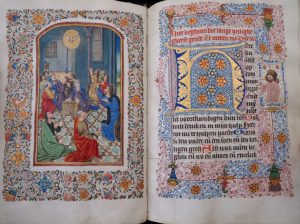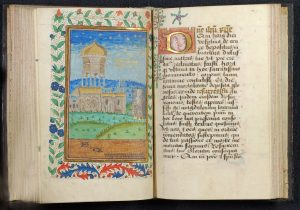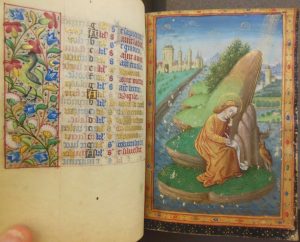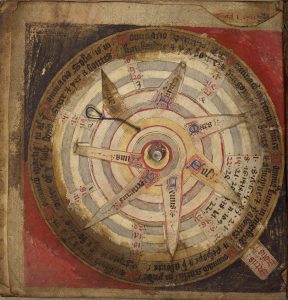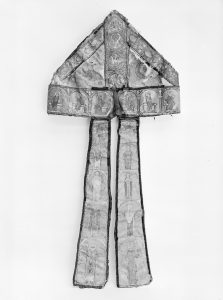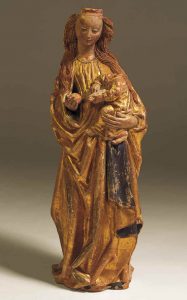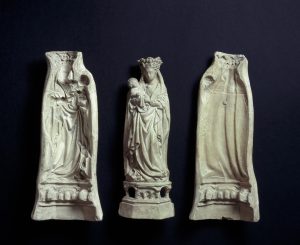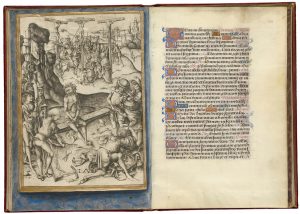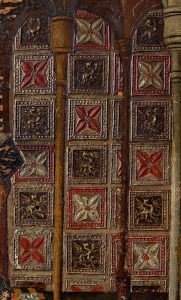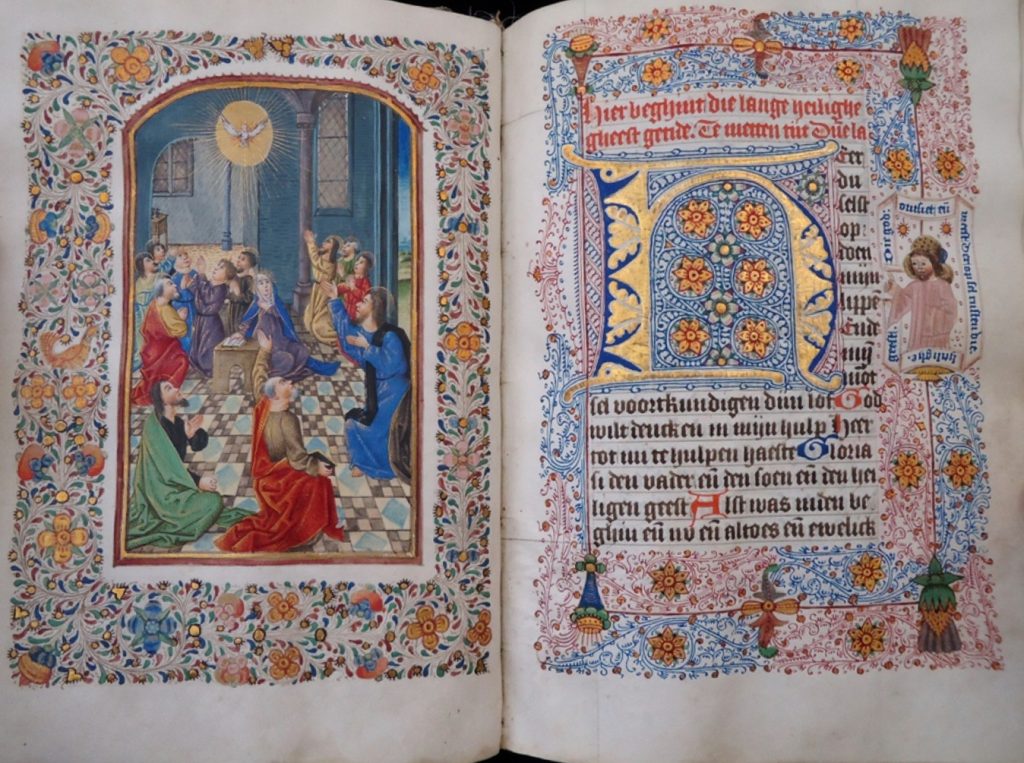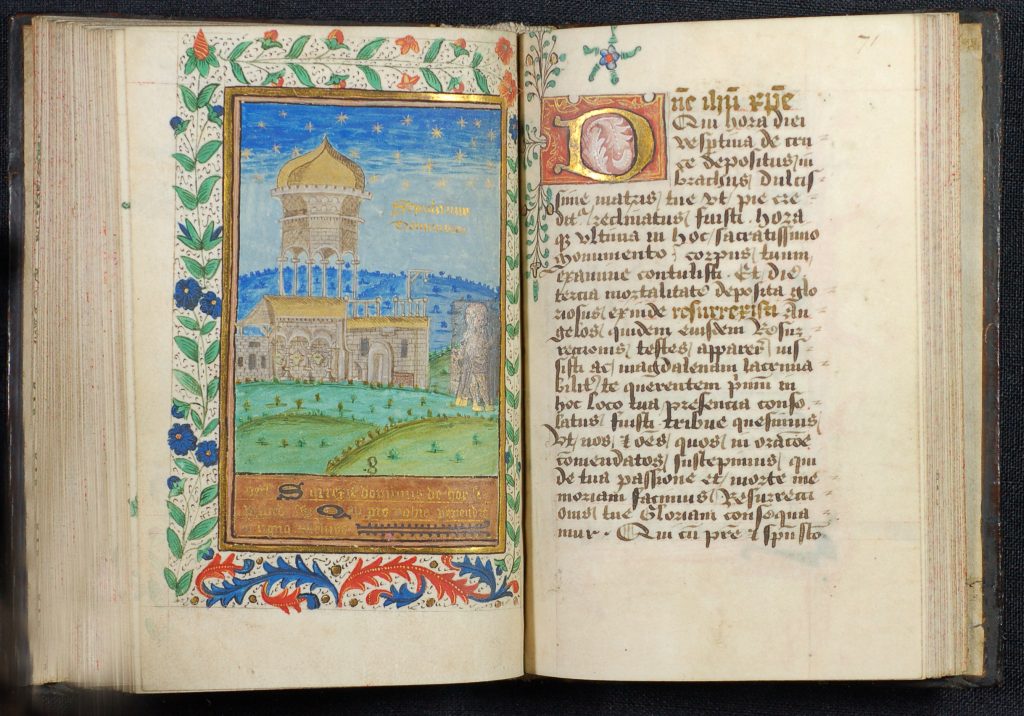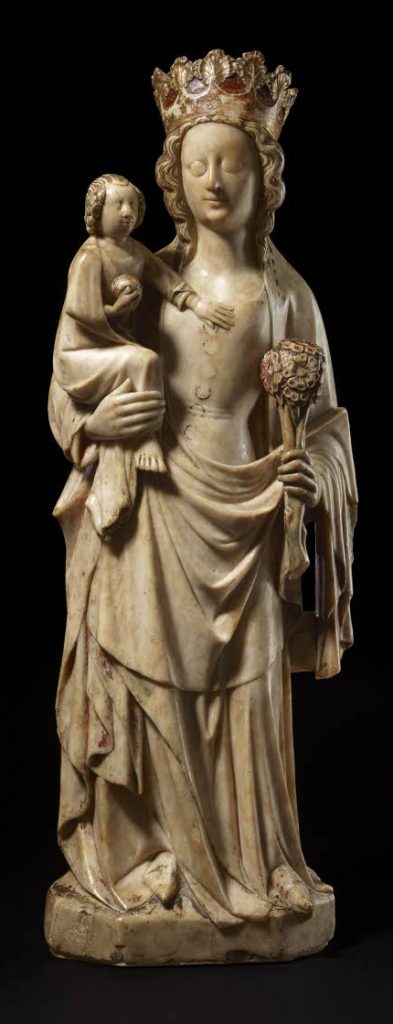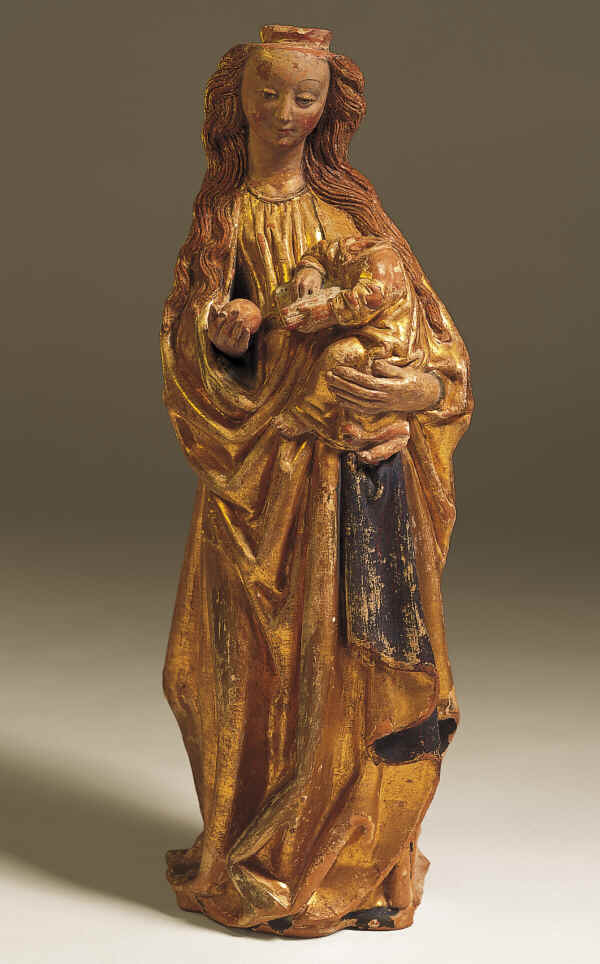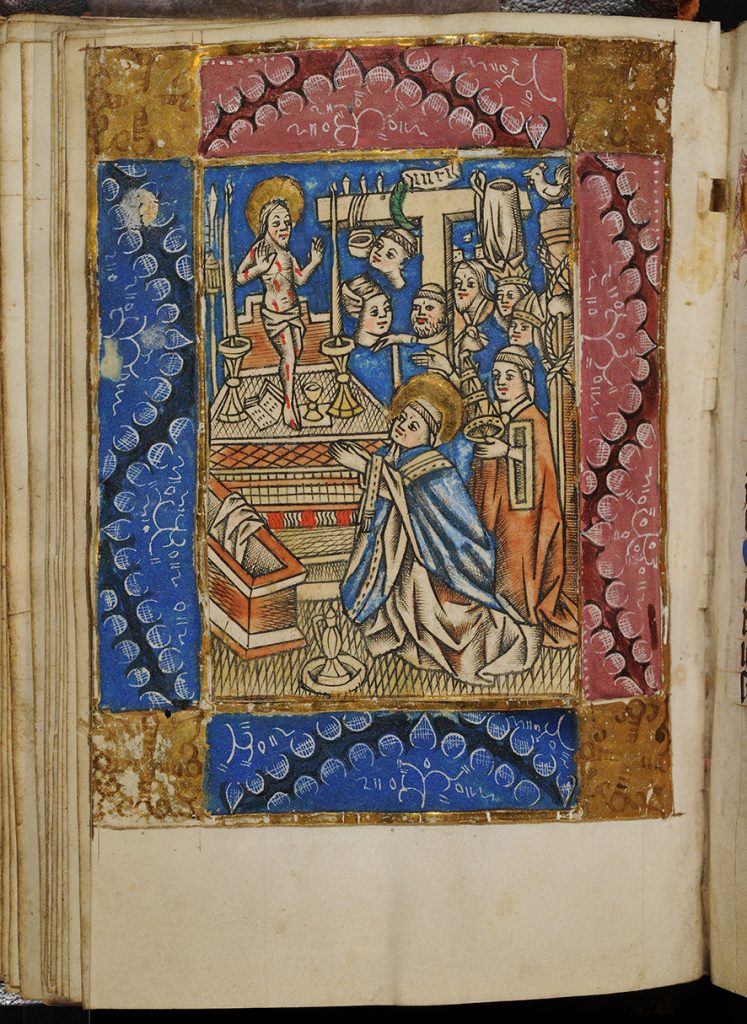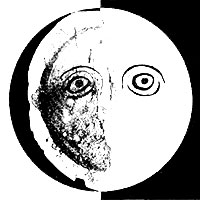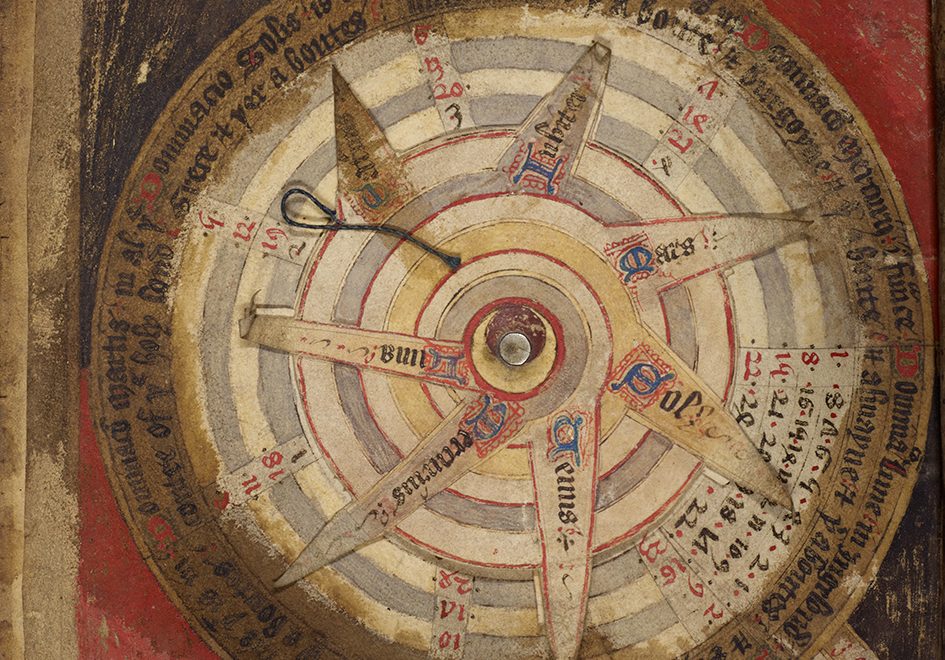
![]()
Abstract
Skeuomorphs are objects or features that imitate the design of similar artefacts made from another material. In the late middle ages, artists employed alternative materials under several conditions: when the challenge of representation exceeded their skill levels, when the ideal material would be too expensive to use, when other physical constraints limited material choice. The resulting skeuomorphs often reveal ingenious solutions to dealing with those constraints.
Abstract (German)
Skeuomorphe Objekte oder Objekteigenschaften imitieren die Gestaltungsweise ähnlicher, aus anderen Materialien gefertigter Artefakte. Im Spätmittelalter nutzten Künstler alternative Materialien unter bestimmten Umständen: Wenn die repräsentativen Erfordernisse ihre eigenen Fähigkeiten überschritten, wenn das für den jeweiligen Zweck ideale Material zu teuer gewesen wäre oder wenn andere äußere Umstände die Auswahl an Materialien einschränkten. Die dadurch entstandenen Skeuomorphismen zeigen daher häufig, wie Künstler auf kreative Weise mit solchen Einschränkungen umgingen.
Table of contents
The work and lifeblood of the Institut für Realienkunde des Mittelalters und der frühen Neuzeit are to document late medieval things, including those only surviving as representations within late medieval paintings. Medieval painters and sculptors spent considerable effort and creativity representing things. In this essay I explore about one strategy for doing so: skeuomorphism. According to a dictionary definition, a skeuomorph is an object or feature which imitates the design of a similar artefact made from another material. In the twenty-first century we are bombarded with skeuomorphs regularly: ‘vellum’ paper, fishing flies, floor laminate patterned to look like hardwood, jewellery made of glass, and human prostheses including 3D printed organs.
Archaeological collections are also full of skeuomorphs. Pots can take the form of vessels in other materials, given the plasticity of clay. For example, the shape of a Greek pottery askos might betray its prototype made of animal skin. Artists and makers often employ old forms when they create an object in a new medium. That new medium is often cheaper or more automated or more mechanically produced than the way the object was formerly manufactured. But cost is not by any means the only important driver. For example, in Morocco, one can find aluminium tagines, that is the covered pot for cooking the national dish combining meat, vegetables, and spices. (The word tagine means both the food and the vessel in which it is made.) Traditionally, tagines were made of fired clay, and the contents cooked over wood charcoal; however, with the advent of butane gas as fuel, a more durable material ‒ aluminium ‒ was adopted, but the shape of the original tagine was kept. Aluminium tagines preserve structural features of the ceramic vessel even though they are redundant in the new material. In this case, a change in fuel source motivated a change in material, but tradition preserved the shape. Verisimilitude, humour, experimentation, sentimentality, nostalgia, or a quest for a sense of continuity with the past can drive the production of skeuomorphs. And they need not be only visual: an oft-cited sound skeuomorph is the digital camera, which makes a recorded clicking sound in imitation of traditional film camera, even though there is no structural reason for it to do so. A necessary feature in the old material often becomes an ornament in the new.
One could speak of degrees of skeuomorphism: an entire object can be made out of a non-original material, or sub-sections can be. Furthermore, a significant category of skeuomorphic objects could be classified as ‘cheap imitations’ and might include items such as Naugahyde couches masquerading as leather ones. But sometimes the boundary between real and imitation may not be clear. Is a polyester comforter a skeuomorph of one constructed of cotton and goose down? Is a seitan burger a skeuomorph of a hamburger, or does it have an independent identity? At what point did the automobile cease being a horseless carriage? The ‘woody wagon’ of the 1970s – a family sedan with faux-wood siding – refers to the Conestoga wagons of the American pioneers, but does so in a playful way. That playfulness as a design element may be more difficult for us to identify in the late middle ages, partly because of our cultural and historical distance. We may not be able to comprehend the degree to which playfulness motivated material choice by late medieval artists. In this short essay, I take a wide view of late medieval skeuomorphs, partly in order to initiate a conversation around this underutilized term in art history.
Premodern skeuomorphs
Some work has already been done on skeuomorphs in architecture, including the use of materials such as illusionistically painted wood to imitate, say, marble or semi-precious stone, especially from the early modern period. From earlier periods, very few painted wood elements survive, and fragments of carved stone survive in greater quantities. Meg Boulton has analysed Anglo-Saxon architectural spolia, which are often carved with skeuomorphic patterns that recall textiles, such as elaborate palls draped over tombs, or ropes with knot work. When the object is made in a different material, the old material is referenced through ornament when its original function is rendered obsolete.
In the European late Middle Ages, image-makers occasionally used alternative materials and experimental techniques in order to suggest different ‒ and often sumptuous or elusive ‒ substances, such as velvet or jewels. For example, a sculptor in the 1170s, making a reliquary for Thomas Becket’s blood, set a piece of glass in front of a piece of red foil in order to give it a sanguine shine. It is, in effect, a fake ruby. One could contrast this with artists who use a material to represent itself: using gold to represent a golden chalice; using the body of a saint to represent the saint, using a hole in a print to represent a gouge in Christ’s side. In this article, I discuss some examples in a variety of media (panel painting, sculpture, book arts) in order to show how skeuomorphs could be part of a maker’s creative repertory when faced with the task of representation. Late medieval painters employed skeuomorphs primarily under two conditions: when practical forces constrained the possible materials they could use; and when their desires for representing things exceeded their skills.
Representing Light
Jan van Eyck is celebrated for having used oil paint to achieve levels of naturalism, by representing inter alia rock crystal such as the staff in the Ghent altarpiece, which bends light in a specific and believable way; oranges in their peels, dimpled and waxy; fur collars that one can imagine touching; a variety of silk materials, including the pattern-voided silk velvet worn by the Canon van der Paele; and glass whose transparency transmits symbolic meaning. Artists with less developed talents found other strategies for representing both things and elusive qualities, namely, by using experimental materials.
In western medieval art, the gold halo forms a shorthand for representing light, which is intangible and therefore difficult to represent. The reflective and expensive material stands in for divine radiance. Manuscript illuminators (i.e., those who illuminate, or bring light), as well as panel and sculpture painters, glued pieces of gold foil to their creations. Across the output of European painting in all media, artisans also burnished and tooled these gilded areas so that the light would break across the surface in intricate ways: they not only ‘represented’ light, but played with it as well. Moreover, in the period around 1400, artists experimented with other materials to represent kinds of light less exalted than holy radiance, such as the light that might stream in from a normal window, not necessarily one transmitting the Holy Spirit. A panel painting made near the end of the fourteenth century with scenes from the Life of the Virgin, which survives as a fragment, provides evidence for material experimentation (fig. 1). It was discovered in 1925, as it had been recycled as part of a chest in the Castle of Alken, which explains its irregular shape and damage. Measuring only 63 cm high but 271 cm wide, it must have formed part of a larger retable. The episodes of the Life of the Virgin appear in a series of archways. The painter has struggled with verisimilitude in both figuration and in creating a convincing fictive space. Included in his toolbox was a technique often seen in paintings of southern Europe: adding impasto to the panel, especially under leaf gold, to bring those sections into a relief whereby the shininess of the gold is even more pronounced than it would be if flat with the picture plane.
But the painter has also carried this technique in a new direction. In order to represent the portal behind Mary and Joseph, he has used another material: moulded sheets of tin. Since he cannot illusionistically paint a framed space that transmits light (without actually perforating the panel), he instead reflects and scatters light by gluing pieces of soft tin that have been stamped with repeating forms of dragons and flowers, and then he has partially painted and selectively gilded these bas-relief sheets. These mechanically reproduced forms connote ‘bright outdoor space’ or ‘arch-framed window’ without presenting the primary characteristic of a window: its transparency. Like a stained-glass window, the stamped form plays with and scatters light, has figurative and abstract imagery, and is segmented. The tin has now oxidized, resulting in a dull grey surface, but originally it must have yielded a shiny and intricate simulacrum of a stained-glass window. Thus, with a limited repertory of skill, the artist has been able to represent an object with elusive properties.
Those who worked with tin may have actively sought to market their wares as replacements for more expensive or highly crafted objects. For example, they moulded small religious jewellery, such as crucifixes with loops to hang them from a chain. Crucifix jewellery made by goldsmiths would have been outside the financial purview of most urban Christians in the late Middle Ages. Likewise, tin workers apparently made decorative edging, which resembles rows of swags, which were used to embellish objects including the besloten hofjes (enclosed gardens) associated with hospital sisters of Mechelen. These early forms of mechanical reproduction both displaced more expensive materials (such as hand-tooled gold crucifixes) and created new items, possibly because the cheapness and repeated nature of the process lent themselves to experimentation and market exploration.
Similar to the solution that the painter of the Brussels Life of Mary panel employed, many illuminators used silver foil in their manuscripts. Whereas silver foil was not much used on panel painting ‒ perhaps because it would tarnish very quickly ‒ book makers did apply silver, possibly because the book in its closed state would limit oxidation, at least temporarily. Silver foil is a solution for representing windowpanes in many fifteenth-century Delft manuscripts, such as one depicting the Pentecost, where the apostles and Mary are receiving the Holy Spirit in a church (fig. 2). The back wall of the chapel where the event takes place has two silver-foil windows, which the painter has further articulated with tracery. Whereas the regular windows are represented with silver, the radiance around the holy dove appears in gold, a higher-value metal that never tarnishes. Other illuminators experimented with silver, including an English painter who tried to represent the resurrected Christ bathed in light, depicted his body in silver (fig. 3). This silver, however, has oxidized, and the resurrected one now appears as a tarnished and solid lump rather than an ethereal hovering being. The experimental material has failed.
- Fig. 2: Opening with Pentecost and the incipit of the Hours of the HolySpirit, from a Book of Hours made in Delft, ca. 1480 (Tuliba Ms 15).
- Fig. 3: Church of the Holy Sepulchre, with Resurrected Christ represented in silver. Oxford, Queens College 357, fol. 70v.
Making things out of parchment
Manuscript illuminators played at the outer boundaries of materials’ possibilities, and parchment was one of the most flexible of those materials ‒ in both a literal and figurative sense. Parchment has a number of qualities that made it useful for certain skeuomorphs in the middle ages: it was relatively inexpensive and abundant across the meat-eating world; it is strong enough to withstand burnishing; it takes paint well, without drinking it; one can cut it into any shape; it does not fray; and it has the structural integrity to lie flat. It differs from panel in significant ways. Whereas Jan van Eyck could paint the wooden frame around his ‘Leal souvenir’ portrait (London, National Gallery) so that the viewer might expect the frame to feel like porphyry, a manuscript painter would have a more difficult task creating a fictive frame. This is because the illumination is always in the context of a book, where the parchment folds around the curving book block. That said, a fictive frame might be an easier trick to pull off than the illusion of figures populating a space inside a frame, because the fictive frame painter does not have to represent fictive space, but only to represent another material. One might reach out to touch the Leal souvenir portrait and expect the surface to feel cold and petrified, that is, to think that it’s porphyry and then be surprised to discover by its temperature that it is actually painted wood. Representing a porphyry slab at the bottom of a panel painting could be considered an extension of architectural skeuomorphism.
Nevertheless, some illuminators even attempted to lend parchment the quality of a solid mass. For example, a French illuminator played with the construction of a fictive material in a full-page design depicting St John on Patmos in a frame (fig. 4). That fictive recession into depth is a different ontological level from the frame itself: the latter is painted in shell gold, the same paint one might use to paint an actual frame. This shell gold provides the visual aspic for the gems and jewels ornamenting its periphery. Not only was the medium of metallic and non-metallic paint on parchment cheaper than jewels and jeweller’s gold, but the former can be closed into a book.
Bookmakers could construct scientific instruments out of parchment for the same reason: the metal prototypes from which a clockmaker or goldsmith could fashion a cosmological dial would not fit within the pages of a book, as would an equivalent tool made of parchment. Consequently, a fifteenth-century English astrological manuscript contains several parchment volvelles, including one for calculating the planetary hour (fig. 5). The instrument consists of a parchment page, together with concentric parchment dials, which refer to metal prototypes. Except in rare instances in which someone carved a recess into a wooden book cover to secret a pair of spectacles, books could not normally accommodate metal instruments. Making them out of parchment instead provided an elegant solution.
Parchment could likewise stand in for other materials outside the book. One enterprising maker took advantage of the semi-rigid flexibility of parchment and made a bishop’s mitre made of it, embellishing it with depictions of saints ‒ including self-referential bishop-saints wearing mitres ‒ and completing the object with represented jewels (fig. 6). These fictive jewels are embedded within the fictive metalwork. Here the parchment can stand in for both the golden armature of the mitre, as well as the embroidered fabric, in the form of the two bands that extend down the back of the ensemble. In this way, parchment approaches clay in its flexibility and plurality of uses.
- Fig. 4: St John on Patmos in a frame. Oxford, Bodleian, Ms. Douce 31, fol. 13r.
- Fig. 5: Volvelle for calculating the planetary hour, in an astrological manuscript, England, mid-fifteenth century. Manchester, Chetham’s Library.
- Fig. 6: Bishop’s mitre made of painted parchment, 12th century. Namur, Trésor d’Oignies.
Just as gold leaf has a low barrier to representing golden objects, parchment, made from skin, has a low barrier to representing skin. Those late medieval sculptors who produced life-sized images of the crucified Christ, with hinged arms and a moving head, could cover the entire sculpture in parchment. This not only concealed the hinges, but could endow the figure with a greater level of veracity, as the parchment not only took the place of skin but provided an ideal substrate for representing bloody wounds on that skin.
Pipe Clay and Alabaster
Beginning around 1330, alabaster was used for carving sculptures. A translucent form of gypsum or calcite, alabaster is quarried in Tutbury and Chellaston in England, along the River Henares in Spain, near Jura in France, and in the northern German provinces. English midlands carvers earned a reputation abroad and began exporting blocks of alabaster, and also finished works, such as altarpiece panels and figures. One of the finest surviving examples is a standing Virgin holding the Christ Child, carved delicately with tender hand and facial gestures and fluid drapery (fig. 7). The material is noteworthy for its luminous, off-white hue, which can take paint. In fact, some polychromy still adheres to the small sculpture, especially in the folds of the Virgin’s gown and in the recesses of her crown.
One place that did not have a source of alabaster was the Netherlands. In the middle of the fifteenth century, artisans made knock-offs of such sculptures that had the same size, iconography, and basic colour as alabaster prototypes, by using pipe clay. Pipe clay is so called because it was used, especially in the seventeenth-century Netherlands, to fashion long-stemmed tobacco pipes whose mouthpieces could be trimmed down successively. Like alabaster, it could also be polychromed and gilded. Although the technique does not allow back-cut, pipe clay could be moulded in several parts and assembled to make it more complex forms, as with a standing Virgin and Child, probably moulded in the 1470s (fig. 8). The right hand, emerging from the sleeve, has been moulded separately to give it a higher degree of verisimilitude. The head is shaped with a stump, so that a crown can be placed upon it. A tin bender and stamper, such as the one we encountered earlier, could have manufactured such a crown.
- Fig. 7: Virgin and Child. Alabaster figure probably carved in the English midlands. London, British Museum, inv. 2016,8041.1. Online.
- Fig. 8: Standing Virgin and Child, ca. 1470-80. Red pipe clay, painted and gilded, made in Utrecht. 54,5 x 19,2 x 15,6 cm. Utrecht, Centraalmuseum, inv.nr. 11790d.
The sculptors were based in Utrecht, the seat of the bishopric for most of the Dutch-speaking north. I suspect that entrepreneurial Utrecht sculptors actively sought a cheaper alternative to the expensive imported devotional sculptures from Nottingham. In searching for a solution, they may have drawn upon the moulded clay figurative sculptures that the Romans had left behind in Traiectum ad Rhenum, what the Romans called Utrecht when they occupied the region. The Romans squeezed clay into a mould and fired it in order to produce dozens, or even hundreds of identical sculptures serially and cheaply. Several antique Roman moulded clay figures, representing Roman goddesses, have been found in archaeological digs around Utrecht. The fifteenth-century technique therefore revives one from antiquity, which the Netherlandish sculptors may have reverse-engineered upon discovering fragments of ancient moulded clay figures among the Roman ruins on which Utrecht was built. It was truly a rebirth of a Gallo-Roman technique that throve in the first to third centuries, had been lost for most of the Middle Ages, and was ‘reinvented’ in the 1420s in Northern Europe. Moulded objects may have been designed to look like alabaster, and to serve as a cheap version of the more expensive material. In a sense, they invented 3D printing, or rather, re-invented it after the Roman technology had been lost.
It is difficult to estimate the number of pipe clay sculptures made in Utrecht in the fifteenth century, as they were fragile, and may have been considered ephemeral. Few survived the iconoclasm of the sixteenth century. However, most of the pipe clay figures that survive today are fragments that were unearthed during accidental excavations and discoveries. Several complete moulds, which comprise a front and a back like a clamshell, were found during the 1844 excavations of the sixteenth-century city walls of Utrecht, and thereby provide some indication of the location of the pipe clay industry within the city. These excavations also unearthed several clamshell moulds, which provide some insight into the vast scope of the pipe clay industry in Utrecht. One such mould, probably dating from the second quarter of the fifteenth century, produced multiples of a standing Virgin and Child sculpture (fig. 9). Two figures apparently pulled from this same mould were found in 1858 in the ruins of the convent of Diepenveen, east of Utrecht. Although nuns and religious sisters would have formed part of the receptive community for such devotional objects, they were probably also destined for lay people, as well.
- Fig. 9: Clam shell mould from ca. 1425-50, Utrecht, with modern impression of the standing Virgin and Child (27 x 9,4 x 5,1 cm). Utrecht, Centraalmuseum, inv.nr. 1856, online. Image copyright CMU.
That the pipe clay industry in the Low Countries was centred in Utrecht is a paradox, considering that the fine clay is not indigenous to the city, and had to be imported from Liège and Cologne. Like English alabaster sculptures, Netherlandish pipe clay sculptures were exported across Europe, such as an entire altarpiece comprising moulded pipe clay figures from Utrecht, now in Segovia, Spain. It is likely that their success stemmed from the efficiency with which they could be produced, as well as their skeuomorphic relationship to devotional sculptures made of more luxurious materials.
Printed images designed to look like other stuff
It is sometimes claimed that early printing in Europe, from the mid-fifteenth century, was first executed on cloth. The resulting fabric could have then masqueraded as labour-intensive brocade. Patterns woven into cloth through one of any number of loom-controlled techniques would have resulted in repeated patterns, which printing techniques could replicate in shape although not in texture. Even with a mechanism for retaining a pattern on a loom and making it replicable, the process of weaving even a simple pattern usually required highly trained manual dexterity, multiple shuttles, and hundreds of individual steps. In Western Europe, printing became the quintessential model for producing repeated designs reliably, cheaply, and with significantly fewer steps than the technologies that printing could replicate.
Today hand-carved wooden blocks of the sort used in printing fabric and paper in fifteenth-century Europe are still in use in fabric painting in India. However, even the process of cutting woodblocks and stamping them in succession is too labour-intensive. Consequently, fabric printers in India use silkscreen techniques made too look like woodblock, but require approximately 90% less time and significantly less skill to make. The silkscreen can be mechanically produced with a photosensitive film, and the large size of a silkscreen ‒ several feet wide and high ‒ can imprint a commensurate piece of fabric with one pass. Covering the same area with woodblocks would require twenty or more imprints, since the maximum size of each block is limited by the size of a cross-section of a tree. Likewise, calabash printing in sub-Saharan Africa is largely reserved for tourists, whereas the actual material is made with silkscreens out of sight. Across the developing world, dying with natural substances is likewise performed for tourists, but chemical dyes mixed to resemble those hues are actually used to colour industrial-sized vats of fabric, off-site. Buyers then as now admired the look, texture, motifs, and colours of hand-crafted objects and could be easily fooled.
Beyond textiles, a skeuomorphic relationship occurs between certain early printing and book illumination. Figures such as the Master of the Berlin Passion produced copper engravings with standard Christological subjects that could be fitted easily into books of hours. As Ursula Weekes has shown, painters, particularly Franciscan convent sisters in what is today the German-Dutch border region, often painted those prints to make them resemble illuminated manuscripts, and gilded the edges of the books with such prints, thereby raising their material status and degree of embellishment, but without having to master the difficult skill of representing human figures. For example, someone has taken an engraving printed on paper and pasted it to a parchment folio in a book of hours, and then painted the borders with red and blue paint and gold. Not only has the print, depicting the Mass of St Gregory, been hand-coloured to make it more closely resemble a manuscript illumination, but the border has been painted to make it look like fragments of intricately-patterned fabric, such as the pomegranate brocade design sought after in Europe (fig. 10). The borders therefore frame a skeuomorph with another skeuomorph.
A French book maker also married script and print into a new confection, but deployed a different kind of skeuomorph in the process (fig. 11). The book is larger than most books of hours, as it has been designed to accommodate the Large Passion series of engravings made by Israhel van Meckenem, a printer active in the Middle Rhine in the fourth quarter of the fifteenth century. Israhel has signed his initials in the foreground, in imitation of courtly flourished capitals. Doing this operation in the plate is a kind of skeuomorph, as it translates a signature into a new medium. A second skeuomorph was applied at the time the book was assembled: the maker constructed a painted frame around the image that resembles marble, thereby transforming the parchment into stone.
- Fig. 10: Mass of St Gregory, hand-painted engraving with painted border decoration, inserted into a book of hours. Brussels, Koninklijke Bibliotheek, Ms. 11059, fol. 17v.
- Fig. 11: Opening in a book of hours, featuring a mounted engraving by Israhel van Meckenem depicting Christ awaiting crucifixion. London, British Museum, Department of Prints & Drawings, inv. 1897,0103.9, also known as London, British Library, Sloane Ms. 3981, fols 33v-34r.
Conclusions
Skeuomorphic decorative features refer to an earlier technology. Artists could use another material when the first choice would require too much skill, or be too expensive. Painters found ways to represent glass with mechanically worked base metals; and wrought gold and gemstones with parchment; and parchment with mechanically worked paper. All of this avoided the skills involved in pushing oil paint into believable forms, or mastering sculptors’ intricate techniques. These transformations often occur at the edges of skill-intensive manufacturing (which etymologically means ‘making by hand’). The examples presented above are by no means exhaustive, and one can find endless modern examples of high-skill craft culture being displaced by cheaper, more industrial, less labour-intensive forms of making. When a maker creates, say, a faux-marble sculpture made of moulded concrete, or any of the items discussed in this paper, she is creating a simulacrum that relies on misrecognition. One wants to believe that the red gemstone is a ruby, even though it is actually red foil behind a clear uncoloured crystal. The context of the faux object can help the beholder to suspend disbelief, which may be necessary, for an image of an image is mimesis twice removed. The deception also relies partly on the beholder’s lack of technical skills. Although such strategies expose the inherent artifice in all representation, they also point to the maker’s creativity in rethinking the properties of materials.



